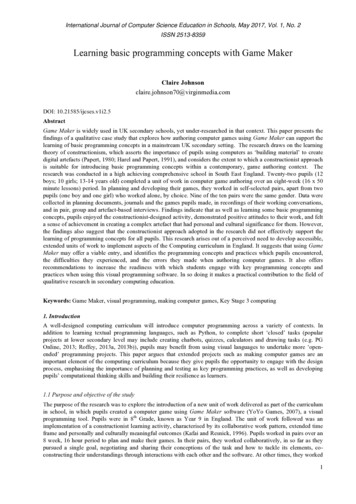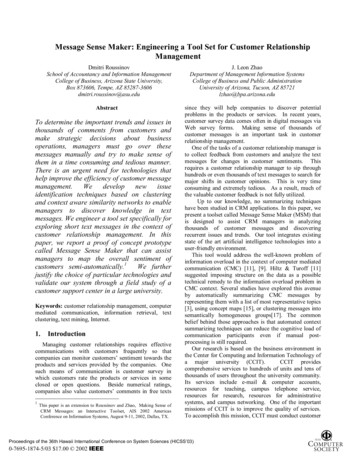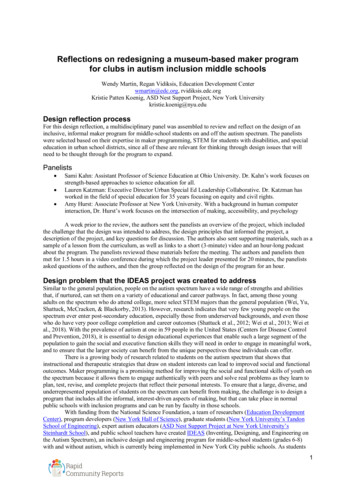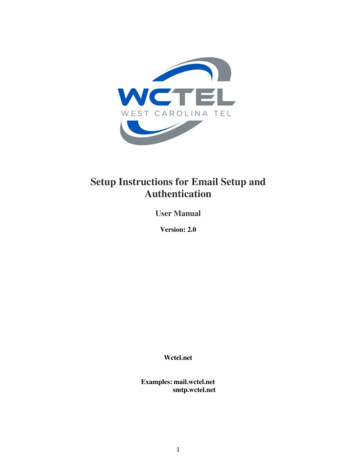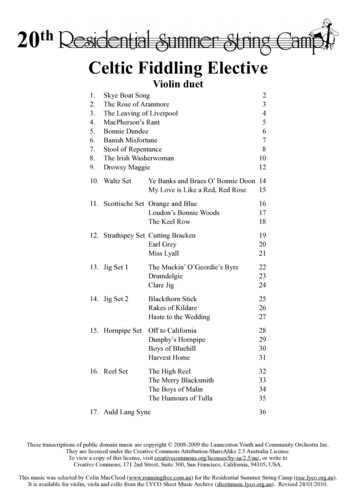
Transcription
--Michael Darnton/VIOLIN MAKING/Setup--[This is a copy of one section of the forthcoming book tentatively titled Violin Making, by Michael Darnton,http://darntonviolins.com, downloaded from http://violinmag.com . It is an incomplete preliminary version, 2009 byMichael Darnton. All publication rights, in any media are reserved. You may download one copy for personal use. Nocommercial use, commercial printing, or posting, either in whole or of substantial parts, in other locations on theinternet or in any other form will be tolerated.]SETUPSetting up the instrument is the last stage of the making process, before the finaladjustments. It involves all of the things that the strings touch, plus the soundpost—thefinal touches that make the instrument playable. In larger shops setup is often considereda specialty job, similar to bow rehairing, because it’s a critical skill different from makingand restoration that benefits from constant repetition. Many makers, if they haven’tworked at some time in a shop doing a lot of setups, are minimally skilled at setup andtreat it as the final impediment to getting an instrument playable and sold.Learning setup mimics learning to make: initially it is a job of numbers andmeasurements, discovering and doing something that works most of the time and is easilyquantifiable in lists of dimensions. Only later does it blossom into a more creative andflexible discipline, determining in conjunction with adjustment the most precise aspectsof how a violin performs. Because of this, there have been people in the violin world whohave made famous reputations based primarily on their abilities at setup and adjustment.It’s not uncommon for players to run directly from buying a new violin to their favoritesetup and adjustment person to set things really right for them.For easy organization of this section, I’ll present setup from the top of the instrumentdown, but that’s not necessarily the order in which operations have to flow.Fitting PegsThe first point of interaction between a player and the violin usually involves the pegsand tuning. Players are particularly sensitive to an instrument which doesn’t work, andpegs are fickle. Ideally, a peg turns smoothly without excess pressure, and stays whereit’s put. Unruly pegs click and jump back and forth around but never exactly on the pitchbeing targeted, and in spite of moving stiffly, don't seem to want to stay where they're set.Fitting and lubricating a peg isn’t difficult, but it must be done precisely. Anything shortof perfect can rapidly become non-functional, but a peg which is done properly will workproperly for a long time—there’s no mystery about it, beyond care.Criteria1
--Michael Darnton/VIOLIN MAKING/Setup-- All pegs should be parallel to each other, and straight to the axis of the instrumentitself, not square to the walls of the peg box. Be sure to view from the front andthe back, and from above, relative to the edges of the top and back.Pegs should project equally from the peg box walls, 35-37mm to the end of thepeg, not within that window, but all set the same, and not including anydecoration on the end of the peg. Some shaped cases will not fit if the pegs extendfarther. New pegs quickly wear in and humidity changes can affect fit, so a pegthat extends 37mm can become a peg that extends 35mm within a couple ofmonths. Burnishing in and compressing the peg holes can help limit this.Pegs should fit perfectly: when fitted properly they will not wiggle in either holeif dropped in gently, but will fit equally tightly in both sides of the peg box, andwhen lubed and run in, will have two equally polished and continuous ringsaround them where they bear against their holes in the peg box walls.The entire shaft and the end should be sanded with 220 grit sandpaper and thenwith 320 grit sandpaper and oil, at the minimum. Sanding to 400, or even to 600grit, is appropriate for better instruments. Sanding should be even and notexcessive so as not to disrupt the taper of the peg, damaging the fit!Ends of new pegs should finish slightly within the outside wall of the peg box,about 1mm inside, to account for some initial seating in through use.Ends of the pegs should be attractively finished slightly domed with sharp edgeswhere the dome meets the shaft, and string holes properly placed, 1/3 of the wayacross the inside of the peg box from the peg head side, facing the player whenthe flat of the peg is turned forward, and finished with a small file bevel asdescribed in the procedure.Pegs should be lubricated so that they turn easily, but stay where they are put.Peg ShapersI prefer the all-brass, three-holed German type. (Alberti Designs makes a moresophisticated and expensive version of this that is functionally even better). The smallesthole, which has a maximum shaft diameter at the peg head of 6.5mm, is used for violinpegs, and the middle hole for viola. On an old instrument, when the holes are worn, usingthe next larger hole size is permissible, but if pegs larger than that are needed, the pegholes should be bushed.Intermediate sizes between the three holes can be achieved by placing a 6mm wideslightly tapered, say to about 5mm, strip of coarse sandpaper long enough to hang outboth ends of the hole, sand surface down, biting on the bottom of the hole in the shaper sothat it doesn’t move, which pushes the peg upwards towards the blade, making theresulting peg slightly smaller. Strips can be stacked to make the hole, and thus the peg,2
--Michael Darnton/VIOLIN MAKING/Setup--even smaller, if necessary. That I mention this option in passing should not be taken thatthis is commonly done—only that it may be, for instance, the way to save reaming a peghole up to the next shaper hole size on an old violin, or on a new one where you’veinadvertently reamed too deeply.The shaper blade must be adjusted before use to exactly match the taper of theindividualy reamer that will be used. Because some reamers have a warp from one end tothe other, you can’t simply adjust the shaper against the reamer by putting the reamer inthe shaper and pushing the blade against the shaper. The only way to do adjust the bladeaccurately is by trial and error, making very small adjustments combined with testing thefit. Instead of a real peg, a stick of wood can be trimmed in the shaper to sample theadjustment against a hole freshly reamed in a solid piece of wood with the appropriatereamer. If you cover the stick with peg dope, the hole in the wood will polish the dopewhere the fit is tighter, and you can read the fit from that.Shaper blades are sharpened more bluntly than any other cutting tool, and don’t thinkthings will go better if you change this. If you want to go in any direction, head forblunter: shapers designed for scraping work more cleanly than cutting ones, but veryslowly. When it eventually comes time to sharpen the blade, measure and record the gapbetween the opposite ends of the blade and the opposing lip on the shaper, right at theclamping screws. When you replace the sharpened blade, you can set these gaps to theprevious dimensions, and not have to go through the entire adjustment procedure again.It’s sufficient to hone the bevel on your finest stone; more likely, you will see lots of wearon the bottom, flat side of the blade, and vigorous stone work on this side with coarserstones, then finer ones, will flatten out this wear. Avoid having to regrind the edge. It’snot impossible, but the small blade is hard to handle on the grinder. When regrinding, usethe same method I use for larger blades of setting the grinder to grind from the center ofthe bevel outwards, and avoid touching the honed edge—stop just short of it, and finishon a stone. Since the peg shaper relies on a very straight edge on the blade, work to keepthe edge accurately straight.If the blade sticks out too far into the peg it will cut quickly, but leave a rough cut. Thismay be all right for the largest hole, which is rarely used for finishing, but for the twosmaller holes the blades should be adjusted to take the absolute minimum cut. Aparticularly clean and polished cut results if the peg must be forced into the shaper a bitbefore any cutting takes place, but this is not always possible to set up. In general,remember that shapers and reamers rarely match, so any difference is compensated for bythe blade adjustment.Reamer3
--Michael Darnton/VIOLIN MAKING/Setup--Though a normal-sized 1:30 peg reamer will work, the smaller ones made for small sizedviolins are perfect for most new instrument work. The smaller size allows a smaller pilothole, which allows more space to align the holes if they have not been perfectly placed inthe original drilling. If you’re doing repairs, the smaller size is good for starting holes innew bushings for the same reason—lots of room for adjustment. The proper size for 4/4violins is reached near the large end of the reamer. For violas, a full-size reamer isrequired, however, and that’s also fine for 4/4 violins that have had larger pilot holesdrilled, if they are properly positioned.Modern violin peg fitting is always done with a 1:30 taper, but if you work with oldinstruments you often will be faced with 1:20 holes as well as varying steep tapers frommachinists’ reamers. It’s handy to have a 1:20 reamer and shaper around for working onthese instruments, both for fitting pegs when the original holes are small but may needrounding up, and for bushing jobs, where having the right reamer eliminates the need toexcessively ream out new wood in the pegbox. In a pinch it’s not too difficult to file-fit aset of pegs once in a while, so you might not need a shaper, but there’s no substitute forthe reamer.Reamers should be stored in paper tubes, kept clean by removing shavings with amarking point or something similar without touching the sharp edges, and must never beallowed to bang against other tools. They last very long if cared for, but once damagedcannot be resharpened effectively.SawA small dovetail saw is required to trim off the peg ends. Almost anything with fine teethwill do, even a small Exacto saw or a coping saw.DrillThe string holes in the pegs are drilled with a 1mm or 1.5mm (1/16”) drill. An electricdrill is efficient, more accurate, and easier to handle than a hand drill for this job, anddrills a cleaner exit hole, if used at its highest speed.Files and Sandpaper, etc.The minimum for this job is a six-inch, coarse flat file (00 hand file), a needle file of thetype used for filing string grooves in nuts and bridges, sandpaper in several grits, andmineral oil. Peg dope, or pumice and soap, will be needed for lubrication. My favoritecommercial brand is Hill, but it must be fresh (not dried out).4
--Michael Darnton/VIOLIN MAKING/Setup--ShapingBegin by turning all of the pegs to the same size in the shaper. Start with the largest holewhere cutting takes place, and work down through the sizes to the final hole required.Several problems can develop shaping the pegs. If a peg is seriously warped along it’slength, the far end of the shaft won’t be pointed towards the center of the head, and in thecourse of shaping the bent end will direct the shaping to end up off-center at the headend. If this is the case, the best correction is to begin shaping in an adjustable shaper, orin a larger holed shaper shimmed with sandpaper so that the whole length of the pegstarts being shaped at once and remains on-target. The adjustable shaper is the easysolution, but they work so poorly that I'm reluctant to suggest that a beginning maker buyone. The only one that I have tried that actually works, and does so well enough toreplace the normal three-hole and four-hole versions is the German Wirbelschneider. It’sexpensive, but performs exactly as promised in the advertising, and is very easy to setand resharpen. Also, it can be quickly set to any desired peg taper, once you have done itonce and recorded the appropriate measurements from the shaper.Pegs with particularly wild grain can trim roughly, with a lot of tearing out of the wood.If this happens, often the best approach is to turn the peg rapidly and gently, but not pushit into the shaper too strongly. Every once in a while you’ll find a peg with such wildgrain that it will grab and break apart in the shaper. This is a good reason forstandardizing on one peg style and buying multiple sets, so that you can mess up anoccasional peg without panicking.The collars at the end of the shaft near the head are always vulnerable to being brokenoff, since the blade begins to cut very deeply as it approaches the head, making a largestep in the shaft thickness near the collar that breaks up in large slivers, inevitablybreaking the collar. The solution to this is to use a sharp knife or small saw to score theshaft next to the rings, and/or when approaching the rings move back to the previoushole, push the peg in all the way, and then shave off the step that has developed in theshaft by pushing upwards against the blade while shaving the step off, then moving backto the proper hole to clean up and finish.When the pegs have been shaped, sand them with 220, then 320 wet-or-dry paper, andfinally 400 and oil, being careful to sand the whole length of the shaft equally. Start withthe finest manageable grade, and the final sanding should be with the grain.FittingStart with the G peg. This is the lowest peg in the peg box and enters from the left side.5
--Michael Darnton/VIOLIN MAKING/Setup--It’s a very common error to start with the E peg in the lowest position, which willnecessitate bushing this hole, and three others if it’s not immediately discovered that thishas been done!Ream the hole, being careful not to push the reamer up or down, back or forward. It’s tooeasy to ream the peg in crookedly, just by inattention. Likewise, it’s easy to straighten apeg by tugging on the reamer in the appropriate direction while reaming, but this shouldbe done early e
The first point of interaction between a player and the violin usually involves the pegs and tuning. Players are particularly sensitive to an instrument which doesn’t work, and pegs are fickle. Ideally, a peg turns smoothly without excess pressure, and stays where it’s put. Unruly pegs click and jump back and forth around but never exactly on the pitch

